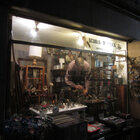I'm fairly new to turning and I'm planning to learn to turn bowls. But I need at least one bowl gouge. I've done a lot of online research and it has left me more confused than informed.
I've joined a local club and been to only one shop day so far. I asked a lot of questions and got a whole lot of responses that came down to personal preference.
One mostly consistent recommendation I've received was parabolic flutes are a great place to start. However the same people were recommending D-Way as their favorite brand. And after doing some more research (a lot on this forum) I'm finding that despite the marketing D-way isn't actually parabolic. But the metal and machining are great. And they're fairly local.
So what is more important the flute geometry or the brand reputation and location?
Or am I just overthinking this?
The other thing I'm confused by is size. Everyone recommended starting with a 1/2 inch, but I can't tell if that's for flute measurement or bar diameter. Because while most online sources agree on 1/2 inch, some of them say to measure tool diameter and others flute.
As you've read from the responses, what's most important depends on who you ask. The bowl gouge is the most discussed tool, due to shaft sizes available, flute shapes, tool steel used, and available grind variations. I'll put my $0.02 in.
For new(er) turners, I recommend they start with hi value tools, ie they hold an edge and are low cost. The best value I know of is Benjamin's Best, usually through Penn State Industries. Their BG's have parabolic flutes and hold an edge well for M2 steel. Why? To me there's no sense grinding up tools that are 3x or more the cost while learning to sharpen and trying new grinds. Getting multiple hi value tools so different grinds can be tried in various situations provides invaluable learning for the new(er) turner. The handles are a bit short (3-4") on the 5/8" shaft BG, but that's a good reason to make your own handle, with a way to remove the tool for sharpening. Large BG's with a handle are a lot to swing around with a jig (which I highly recommend vs platform sharpening) - removing the tool from the handle can immediately improve your sharpening.
Flute - parabolic suites any grind, and is easier to get good shape. Other flute shapes can work for various grinds but can be more difficult to get the "just right" shape. Parabolic also seem to clear chips the best.
BG size - 5/8" shaft and 3/8" shaft. I can do anything with a 5/8" that I can with a 1/2", and the 3/8" will get in where the 5/8" won't, and the 3/8" is good for final finish cuts at the rim when vibration is a problem.
Material - once one has sorted out sharpening and preferred grinds, M42 and V10 materials are worth long consideration. The V10 in Thompson tools definitely holds an edge longest, but that's not necessarily the best thing. It is also more brittle. I started using a Thompson/Jamieson 5/8" shaft BG sharpened with long wings, 45° nose and relieved like a Michelsen grind, for rough roughing - my blanks are chainsawed log pieces with bark, knots, etc. Lots of interrupted cuts through gnarly stuff. On 2-3 occasions I had a chunk of tool edge blow out due to brittleness. This had never happened with M42 or M2 with the same grind. As for edge holding, one should resharpen before finish cuts, which tends to remove the longer lasting edge advantage of the V10. M2 works fine and can be a lot more economical for the new(er) turner.
Location (of mfr I assume) - irrelevant to me. Anything I get will be ordered online - nothing within hours of driving.
Grinds - the most flexible grind for me is the long wing Ellsworth/Michelsen grind (relieved with 2nd and 3rd bevels) with ~60° nose. The short primary bevel does 3 things for me - 1) less drag, 2) goes around a sharper corner inside a bowl vs a full bevel, 3) quicker to resharpen with my wet grinder. The other advantage of the Michelsen grind is a higher bevel angle on the wings, which provides more control when doing a slicing cut (which I use a lot on bowl OD's). I can easily use this tool and a 1/2" spindle gouge to do a bowl. It's not the best tool for some cuts, but is good enough. In all I use 4 grinds on 5/8" shaft bowl gouges, long wing 45° and 60° nose angles, 40/40, and a traditional grind at ~60° - the less swept wings make for a better bowl bottom cut, and can be used on the OD with a push cut.

